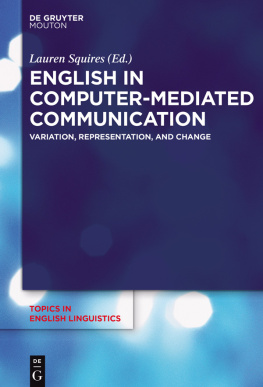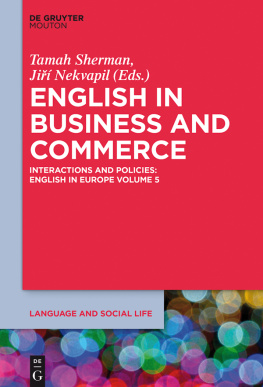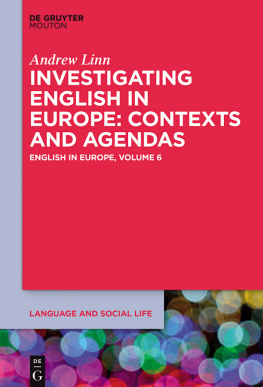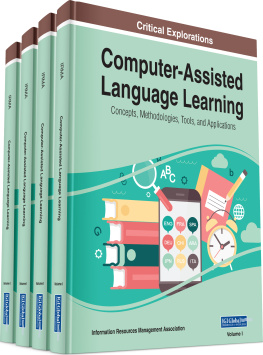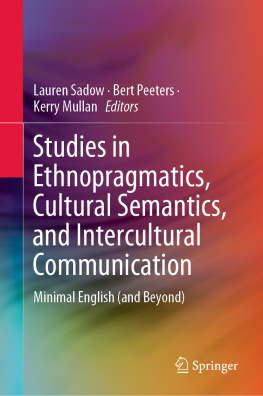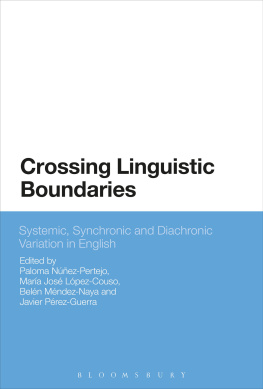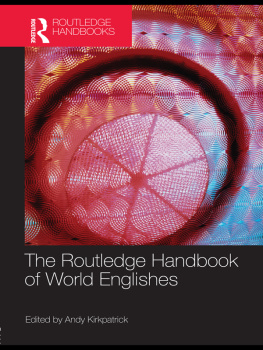Guide

Lauren Squires (Ed.)
English in Computer-Mediated Communication
Topics in English Linguistics
Editors
Elizabeth Closs Traugott
Bernd Kortmann
Volume 93

ISBN 978-3-11-048832-6
e-ISBN (PDF) 978-3-11-049081-7
e-ISBN (EPUB) 978-3-11-048843-2
ISSN 1434-3452
Library of Congress Cataloging-in-Publication Data
A CIP catalog record for this book has been applied for at the Library of Congress.
Bibliographic information published by the Deutsche Nationalbibliothek
The Deutsche Nationalbibliothek lists this publication in the Deutsche Nationalbibliografie; detailed bibliographic data are available on the Internet at http://dnb.dnb.de.
2016 Walter de Gruyter GmbH, Berlin/Boston
Cover image: Brian Stablyk/Photographers Choice RF/Getty Images
Typesetting: RoyalStandard, Hong Kong
www.degruyter.com
Contributors
Axel Bohmann
The University of Texas at Austin
204 W 21st Street B5000, Calhoun Hall
Austin, TX 78712-1164, USA
Markus Bieswanger
University of Bayreuth
95440 Bayreuth
Germany
Patrick Callier
Lab41
Menlo Park, CA, USA
Becky Childs
Department of English
Coastal Carolina University
P.O. Bo 261954
Conway, SC 29528-6054
USA
Steven Coats
University of Oulu
English Philology
Faculty of Humanities, P.O. Box 1000,
FIN-90014
University of Oulu
Finland
Lauren B. Collister
University of Pittsburgh
3960 Forbes Avenue
Pittsburgh, PA 15260, USA
Cecelia Cutler
City University of New York, Lehman College
250 Bedford Park Blvd.
West Bronx, NY 10468, USA
Matt Garley
York College, City University of New York
94-20 Guy R Brewer Blvd.
Jamaica, NY 11451, USA
Theresa Heyd
Freie Universitt Berlin
Institut fr Englische Philologie
Habelschwerdter Allee 45
14195 Berlin
Germany
Lars Hinrichs
The University of Texas at Austin
English Department
204 W 21st Street, B5000
Austin, TX 78712, USA
Josh Iorio
Virginia Tech
1342 Perry Street
Blacksburg, VA 24061, USA
Taylor Jones
University of Pennsylvania
Department of Linguistics
619 Williams Hall
255 S. 36th Street
Philadelphia, PA 19104-6305, USA
Nathan LaFave
New York University
Department of Linguistics
10 Washington Place
New York, NY 10003, USA
Benjamin Slade
University of Utah, Languages and
Communication Building
255 South Central Campus Drive, Room 2300
Salt Lake City, UT 84112, USA
Lauren Squires
The Ohio State University
Department of English
421 Denney Hall,
164 Annie & John Glenn Ave.
Columbus, OH 43210, USA
Lauren Squires
Introduction: Variation, representation, and change in English in CMC
1Introduction
Computer-mediated communication (CMC), once a domain of interaction exciting for its novelty, is now squarely mundane in the business of daily life for much of Anglophone culture. This is at least true in heavily mediatized, networked societies, and it is also true in places where personal computer access is rare but mobile phones afford a widely accessible form of screen-based communication. At the same time as the presence of computing devices has come to seem ubiquitous, the capabilities of those devices have become ever more sophisticated and, in some cases, genuinely surprising.
This fast-paced trajectory of innovation has been accompanied by a steady churn of scholarship devoted to understanding human social behavior with, through, and because of digital media. Centrally in internet studies, communication studies, and sociology, scholars have endeavored to locate the line between the extraordinary and the ordinary. What are people doing with, through, and because of new technology that they were not doing before? What are they doing differently than before? And what are they doing in the same ways, but for different reasons, or with different outcomes? In terms of linguistic behavior, Herring (2013) summarizes these possibilities as discourse familiar, recon fi gured , or emergent . But already nearly a decade earlier, Herring (2004) aptly considered the issue in a paper suggesting that CMC may have been slouching toward the ordinary. Specifically, Herring (2004: 34) put forth a prediction that the internet would, five years hence, be a simpler, safer, and for better or for worse less fascinating communication environment, and continue to evolve in that direction.
More than a decade later, it is certainly true that some of the communication happening in CMC has lost its edge. But it is also true that in other ways, things have gotten more complex there are more media available, more configurations of the media that exist, more platforms, more economic complications, more millions of interlocutors, more layers of intertextuality and there remain risks, both physical and symbolic. Language, of course, continues to be central to our use, negotiation, and understanding of digital spaces.
It is perhaps the ostensible ordinariness of CMC now that has motivated the chapters in this volume to take the approaches they do, in various ways. In much previous research on language in CMC, more so in the earlier days but continuing up to now, the focus was on how CMC was changing linguistic practice, how CMC created spaces for new kinds of language. We have come to a point of acknowledging that in many of the most important ways, language used through CMC is just like language used outside of it. It is thus ordinary in the sense not only of being everyday, but also in the sense of being typical in the way that it participates in linguistic and social processes. English within CMC, as with English in non-mediated environments, is best characterized by diversity and variety, rather than homogeneity.
As the terms in the subtitle of this book preview, the authors here examine English in CMC as it relates to these ordinary processes of variation, representation , and change , all broadly construed. We take for granted that language in CMC varies; language in CMC is represented and represents; language in CMC changes and is changed. These premises position us to ask the much more interesting how questions, approached from a range of analytical perspectives including quantitative language variation, diachronic change, language contact, language ideology, sociolinguistic identity, social networks, and style.
Computer-mediated communication is a broad designator that encompasses multiple semiotic/linguistic modes (including voice, text, and image) as well as technological interfaces and platforms (mobile phones, tablets, social media, immersive online games, virtual workplace environments, and more). The term circumscribes communication that is carried out via a mediating interface, and these mediating interfaces produce layers of structure that require linguistic and social negotiation. No matter the environment whether face-to-face, in a chat room through a computer, or messaging via a phone where there is human interaction, there is language. As a functional and symbolic system, language is perhaps the ultimate carrier of humanness into the disembodied (though not entirely so) realms of the digital. As we send linguistic material through them, computers become vehicles of interpersonal interaction and all that it entails: social change, identity formation, teamwork, and community creation, along with the very human tendencies toward exclusion, harassment, and misunderstanding. It is language that gives these media their social purposes. And language takes with it to these digital spheres all of its history and possibility, its politics, its social stratification, its structural ambiguities, its mutability. Through the use of language in CMC, cultures are formed, social goals are accomplished, ideologies are shaped, power is contested, and sociolinguistic boundaries are crossed and blurred.

